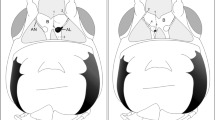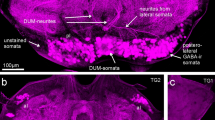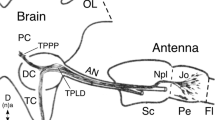Abstract.
Identified dorsal unpaired median (DUM) neurones of the locust Locusta migratoria were stained intracellularly with large amounts of cobalt to reveal their extensive peripheral branching patterns. Two neurones of the suboesophageal ganglion were studied as well as several neurones of thoracic ganglia. The peripheral branching pattern of all these neurones is described completely. As expected, the prevalent target organs of all DUM neurones are skeletal muscles. In addition several, but not all DUM neurones studied here form neurohaemal release sites on the surface of peripheral nerves and thus represent potential sources for octopamine acting as a neurohormone.
Similar content being viewed by others
Author information
Authors and Affiliations
Additional information
Received: 3 March 1997 / Accepted: 12 May 1997
Rights and permissions
About this article
Cite this article
Bräunig, P. The peripheral branching pattern of identified dorsal unpaired median (DUM) neurones of the locust. Cell Tissue Res 290, 641–654 (1997). https://doi.org/10.1007/s004410050970
Issue Date:
DOI: https://doi.org/10.1007/s004410050970




